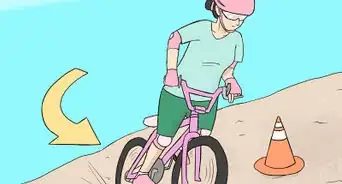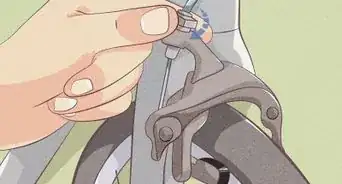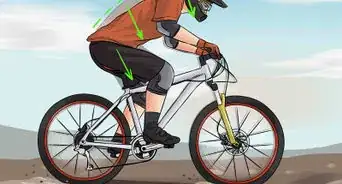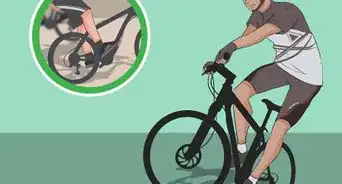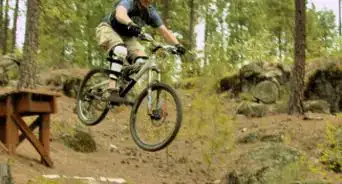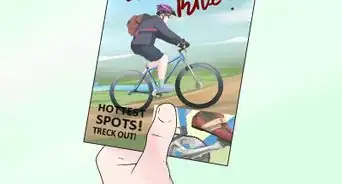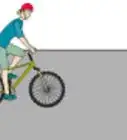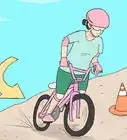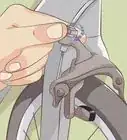This article was co-authored by wikiHow Staff. Our trained team of editors and researchers validate articles for accuracy and comprehensiveness. wikiHow's Content Management Team carefully monitors the work from our editorial staff to ensure that each article is backed by trusted research and meets our high quality standards.
This article has been viewed 113,244 times.
Learn more...
Wheelies can be fun to attempt, and of course they are a sure way to impress your friends. You can do two basic types of wheelie. The pedal wheelie is usually done as a trick, and should be learned first. The manual wheelie or "coaster" wheelie is generally considered more difficult. It can be useful on the trail for whenever you’ll need to lift your front wheel over obstacles in your path, such as rocks or tree roots. Whether you choose to attempt one wheelie or both, they'll help you to improve your reflexes on the trail and in the city, plus your overall balance on the bike.
Steps
Attempting the Pedal Wheelie
-
1Wear a helmet. You should wear a helmet just when doing general riding. So it is especially important to wear one when attempting a trick like a wheelie, where you're more in danger of falling than usual. And you'll get the respect of your friends and fellow riders for showing that you're not reckless, and are taking bike riding seriously.
-
2Choose the terrain that best fits your ability. You might want to begin practicing on a level grass field in case of a fall. Test the flatness of the field by riding through it once before beginning. Otherwise, if you're confident enough, find a slightly uphill dirt or concrete path. [1]Advertisement
-
3Adjust the seat to a low position. You'll be sitting down for the whole trick, and the lower you sit the better-positioned your center of gravity will be. But make sure you're able to sit firmly on the saddle without slipping off the back. Test this by lifting the front wheel at a standstill and leaning back on the seat. [2]
-
4Start off in a low-to-medium gear, at a little faster than a walking pace. If you start in too high or too low a gear, it will be difficult to pedal with enough force to lift the front wheel. Adjust the gears higher or lower as you find the right speed for your ability and the terrain. [3]
-
5Set the cranks at the 11 o'clock and 5 o'clock position. This allows you to put as much drive as possible into your initial pedaling. You'll want to initiate the first thrust from 11 o'clock with your strongest leg, which should be the leg you usually begin pedaling with from a standstill. [4]
-
6Shift your weight forward. Bend your arms and move your upper body over the front of the bike in a crouch position, but stay sitting.This will help you to "load the spring"--you're positioning your body toward the front at first in order to create more force for the sharp backward movement that will follow. [5]
-
7Lean back quickly over the rear wheel. This should be done with a sharp movement, giving a strong pedal stroke at the same time. Let your arms straighten without pulling the handlebars back (the front wheel should pop up without your needing to pull back).
- Continue pedaling at a consistent rate. If you stop pedaling, the front wheel tends to fall back down.
- Keep your fingers on the rear brake--this is your safety in case you feel yourself losing balance and tilting too far backward.
-
8Control sideways and vertical balance at the same time. Feather the rear brake (to lower the front wheel) or pedal (to lift the front wheel) to adjust the vertical balance. To help balance sideways, flare your knees or arms out, or turn the handlebars in the direction opposite to the side the bike is leaning to. [6]
-
9Straighten the front wheel before bringing it down. Lean slightly forward and let the front wheel land softly back down. Be careful not to lean too far forward, just try to shift your weight back to center.[7]
Learning the Manual Wheelie
-
1Wear a Helmet. You'll be going faster while doing the manual wheelie than when doing the pedal wheelie, making a potential fall more dangerous. You'll feel more at ease wearing a helmet by knowing that if you make a mistake and fall, you'll be well protected.
-
2Start on a slight downhill slope at medium speed. It will be easier to coast with this wheelie on a decline once you've figured out your balance. Since you won't be pedaling, the downhill slope will help keep the bike moving at a steady speed.
-
3Position your feet and hold the pedals in place. Set the cranks level with each other at the 9 o’clock and 3 o’clock position, and stand up on the pedals with your knees slightly bent. Your weight should be just back of center. The cranks will rotate slightly as you move backwards, but otherwise you won't need to pedal.[8]
-
4Lean forward over the handlebars, then lean back quickly. The front wheel should be lifted mostly by the shift of your weight backwards, and only slightly by lifting the handlebars. Lock your arms straight, keeping your feet level with each other on the pedals. Your rear end should be behind the seat at this point, and your body should have a “U” shape, with the arms and legs straightened.[9]
-
5Center your weight over the rear wheel. To be able to coast with the front wheel off the ground, you’ll need to find a point of balance over the rear wheel and hold it there. As your arms straighten and you lean back, push forward on the pedals with your feet (but don’t pedal) to adjust your balance. [10]
-
6Keep the front wheel 1 to 1 ½ feet off the ground. Steady your balance and coast for as long as you need to. If you feel yourself falling too far backward, feather the rear brakes to bring the wheel down.[11] If the front wheel begins to fall forward, rock your hips in a backward motion while pushing outward on the pedals. [12]
- Most obstacles on the trail won’t be much higher than a few inches (tree branches, rocks). But in order for you to be able to coast with the front wheel off the ground, you need to fix your center of balance over the rear wheel, and this should bring up the front wheel at least one foot.
-
7Bring the front wheel down steadily. Either feather the rear brakes or shift your center of gravity forward to bring the wheel softly down. If you're avoiding obstacles on the trail, make sure the path is clear before finishing the wheelie--bringing the wheel down directly onto a rock or branch could cause a fall.
Community Q&A
-
QuestionWhat if my bike has no suspension?
 Mark CortezCommunity AnswerWell, it all depends on how you manage your weight. In my opinion, I actually think bikes without suspension (or bikes with only front suspensions) are easier to use for wheelies.
Mark CortezCommunity AnswerWell, it all depends on how you manage your weight. In my opinion, I actually think bikes without suspension (or bikes with only front suspensions) are easier to use for wheelies. -
QuestionHow do I do it on a much heavier mountain bike?
 Matt GanderCommunity AnswerLow gear, lean back, start slow, pedal really hard.
Matt GanderCommunity AnswerLow gear, lean back, start slow, pedal really hard. -
QuestionWhat if I'm overweight?
 Community AnswerCheck your bike's weight limit, but otherwise, just keep riding, it's a great way to lose weight. You may not be able to do a wheelie right away, but if you keep riding and practicing, you'll get there.
Community AnswerCheck your bike's weight limit, but otherwise, just keep riding, it's a great way to lose weight. You may not be able to do a wheelie right away, but if you keep riding and practicing, you'll get there.
Warnings
- Never use a bike with pedals where the shoe locks in (toe clips) or with toe straps. If you fall backwards, your feet can get stuck and you won’t be able to break your fall.⧼thumbs_response⧽
- If you’re practicing on a road or path, make sure it is clear of other bikers and pedestrians before beginning. Also try to practice away from light posts, trees, and parked cars⧼thumbs_response⧽
- Make sure the bike is fully in gear before pedaling.⧼thumbs_response⧽
- Never lean all the way back.⧼thumbs_response⧽
- Make sure your rear brake is working at 100% before attempting wheelies. Using it is the best way to bring down your front wheel, preventing you from falling back and off the bike. [14]⧼thumbs_response⧽
References
- ↑ http://www.mtbiking.com.au/skills/how-to-wheelie
- ↑ https://hansrey.com/how-to-do-a-wheelie-on-a-bike/
- ↑ https://hansrey.com/how-to-do-a-wheelie-on-a-bike/
- ↑ https://hansrey.com/how-to-do-a-wheelie-on-a-bike/
- ↑ http://www.mtbiking.com.au/skills/how-to-wheelie
- ↑ https://hansrey.com/how-to-do-a-wheelie-on-a-bike/
- ↑ https://hansrey.com/how-to-do-a-wheelie-on-a-bike/
- ↑ https://vimeo.com/89343498
- ↑ http://www.mtbiking.com.au/skills/how-to-wheelie
About This Article
To do a pedal wheelie on a mountain bike, it’s best to start on a level field in case you fall. You’ll need to be in a low to medium gear at a fast walking pace. Then, move your pedals to 11 and 5 o’ clock. When you’re ready, shift your weight forward, then lean back quickly over the rear wheel. As you lean back, push the pedals hard. This should pop your front wheel up. To keep it in the air, keep pedaling at a steady pace while balancing over the rear wheel. Keep your fingers on the rear brake and squeeze it gently when you want to bring the front wheel back down. For more tips, including how to do a wheelie without pedaling, read on!
-Step-1-Version-2.webp)
-Step-2-Version-2.webp)
-Step-3-Version-2.webp)
-Step-4-Version-2.webp)
-Step-5-Version-2.webp)
-Step-6.webp)
-Step-7.webp)
-Step-8.webp)
-Step-9.webp)
-Step-10.webp)
-Step-11.webp)
-Step-12.webp)
-Step-13.webp)
-Step-14.webp)
-Step-15.webp)
-Step-16.webp)
